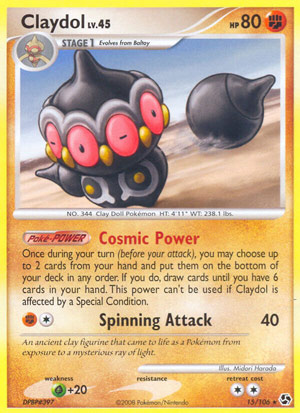
Claydol – Great Encounters
Date Reviewed: October 21, 2021
Ratings Summary:
Standard: N/A
Expanded: N/A
Ratings are based on a 1 to 5 scale. 1 is horrible. 3 is average. 5 is great.
Reviews Below:

Vince
This week’s Throwback is Claydol from DP Great Encounters!
This is a card from the Diamond & Pearl series, and while this card has left rotation for over a decade ago, it doesn’t change the fact that Claydol has, if not the, one of the best Pokemon Power to utilize. Its Poké-Power, Cosmic Power, lets you put up to two cards from your hand to the bottom of your deck. If you do that, then you get to draw cards until you have six cards in your hand. This is some serious draw power in its time, and probably still is today if it were to be reprinted. While you might get Claydol via Celebrations booster packs, this card is not legal to use in the Standard or Expanded format, unfortunately.
Anyhow, Claydol debuted when there weren’t many potent Supporter cards at the time. I’m guessing there’s Cynthia’s Feelings, but she is a shuffle-then-draw, and so is Professor’s Oak New Theory. Which means there weren’t many straight-draw Supporter cards outside of Felicity’s Drawing. It wasn’t until two sets later that Uxie had another great Poke-Power that could either be used alongside Claydol or on its own. Uxie’s Set Up Poke-Power is a insanely powerful ability, and if it doesn’t convince you enough, Shaymin-EX from XY Roaring Skies is banned from Expanded! Let that sink in: Shaymin-EX is weaker than Uxie due to giving up two prizes and makes your hand yield six cards instead of seven, and it’s still banned there. No way Uxie would ever set foot on that format. In the end, both Claydol and Uxie were in the spotlight of being the best cards of 2008, with Uxie being second place while Claydol takes first place (https://www.pojo.com/COTD/2009/Jan/16.shtml). It’s first ever review is here (https://www.pojo.com/COTD/2008/Feb/27.shtml).
It wasn’t safe on the Bench for long, with at least two notable cards that gave Claydol a hard time. Volkner’s Luxray LV.X SP had Bright Look which functions like Gust of Wind (or Boss’s Orders in present day), while Cynthia’s Garchomp LV.X SP had an attack which deals exactly 80 damage to any of your opponent’s Pokemon, so even Claydol on the Bench will get OHKOed. That doesn’t mean you should drop Claydol, but don’t expect Claydol to stick around for more than one turn if they already have those Pokémon in play. This review from August 2011 painted an accurate picture of Claydol’s viability if it remained legal, and that’s the most recent review before today’s Throwback.

Otaku
As you may know, Celebrations is more than just the 25 cards numbered for the set; besides some related SW – Black Star Promos, the set contains 25 reprints that span the life of the Pokémon TCG! Don’t get too excited, though: these reprints use the original set information and have no regulation marks. You can still tell the re-release apart from the originals, as they have that the same 25th-anniversary stamp on it as other cards from Celebrations. The main thing is they are not legal for the Standard or Expanded Formats. They’re just fun collectibles and… obvious choices for Throwback Thursdays! Up first is Claydol (DP – Great Encounters 15/106).
I can find three past reviews for this card:
Note that the January review was part of a countdown for the Top 10 Cards of 2008: Claydol took 1st-Place! Some reminders when reading older reviews are things change. Rules, mechanics, and terms have all changed greatly over the years… plus acceptable nicknames or alternate formatting might stumble into a later official term. Just like when using older cards in the present, you need to read and understand articles in accordance with what these terms meant at the time. Unlike when using older cards in the present, you also need to understand them according to the rules of the past, instead of forcing them to conform to the modern day rules.
So, onto Claydol itself. This Claydol is a baseline Pokémon. Remember, “baseline” isn’t an official term, just one I use for something that doesn’t have any
- name deviations, like an owner or a region
- any “bonus” mechanics, like a Battle Style, being an Ultra Beast, etc.
- any Rule Boxes
Which is nice, because even that brief explanation required addressing something only found in Expanded, and having to explain such things from 10-13 years ago will take a lot of time and likely be confusing. As stated above, there were name variants when this card released, there were oddball mechanics that are hard to classify, and there were Rule Box Pokémon that are different-but-similar to modern Rule Box Pokémon. Plus changing game rules and game terms.
Claydol’ss [F] typing was at least somewhat good around the time it released. I don’t remember if type-based support was all that great back then, but [F] Weakness was still one of the most abundant, even back then. [F] Resistance was also one of the most common forms of Weakness, but it is much easier to bypass a specific form of Resistance than it is to exploit a specific form of Weakness and “no Resistance” was far more common than any form of Resistance. Being a Stage 1 was better back when Claydol was Standard-legal. Yes, the third review mentions how the metagame was becoming more Basic-Pokémon-focused, but that Claydol review was written after it had rotated from Standard-play (and before Expanded was a thing).
Claydol has 80 HP. This was poor when the card released, and is still poor now. The amazing thing is that the decline hasn’t increased as much as I would have expected due to power creep. Besides cards like Level Ball helping low HP Pokémon out, once you’re a OHKO, it takes a massive amount of power creep to become relevant. [G] Weakness +20 is one of the ways the game was different back then. It wasn’t too bad of a Weakness to have back in the day but… yeah, I’m busting out the soap box again:
At first, the powers-that-be appeared to be phasing out x2 Weakness. They then brought it back as a Stadium effect, then they decided that “really powerful” cards may as well be printed with it as a means of game balance and… I miss +20 Weakness. Damage multipliers are far more difficult to balance than simply adding or subtracting from damage. At the time Claydol was new, cards might have +10 to +40 Weakness… I think the mistake was making it variable, then trying to blend it with x2 Weakness. Changing Weakness to be just +20 or just +30 across the board seems like it would keep exploiting Weakness relevant without it causing too dramatic a swing.
Okay, with that out of the way, we see that this card has no Resistance. That is how most cards are now and were back then, so while it annoys me, it doesn’t actually detract from the card. It’s printed Retreat Cost was [CC]. This was also quite typical of the time, but I think I went a bit too easy on the Retreat Cost in the one review of the past three in which I’d participated. It wasn’t too hard to pay, but it wasn’t easy, either. I’m going to skip to the card’s attack because it is mostly filler. “Spinning Attack” does 40 for [FC], and while this is abysmal now, it just underwhelming back in the day. After all, HP scores were lower back then.
Claydol has the Poké-Power “Cosmic Power”. Poké-Powers are not Abilities, but they operate in a similar fashion. There were ways to shut them off as well, besides what might be printed in the individual card’s text. Each instance of Cosmic Power may be used once, during your turn, before you attack or do anything else that ends your turn upon resolution. You may choose up to two cards from your hand, then place them on the bottom of your deck. Then, you draw until you have six cards in your hand. You also cannot use Cosmic Power if that Claydol is affected by a Special Condition.
You have to bottom deck at least one card to use Cosmic Power, so if your hand is completely empty or there’s nothing you believe you can spare, you cannot use this Poké-Power. You can use Cosmic Power even if it leaves you with six or more cards before you’d draw. You just bottom deck the one or two cards you wanted to, then you don’t draw as your hand already contains six or more cards. This leads into how having to bottom deck one or two cards is one of those costs that are often beneficial. While the ideal combos would involve effects that need a specific card on the bottom of your deck, that isn’t what I’m talking about. While thinning your deck can be valuable, so is being able to bottom deck stuff that isn’t useful now but might be later. Plus, if everything in your hand is at least kind of useful or needed, it is better to just have to shuffle one or two of those cards back into your deck than having to discard them. Ideally, of course, you’d have the option of not shuffling any away, but Cosmic Power always requires at least one card be bottom decked.
Claydol’s Cosmic Power was the driving force behind many decks while it was Standard-legal… or rather, Modified-legal as the Standard Format was referred to at the time. For the 2008 World Championship decks, the “Empotech” (Senior Division Champion) and “Psychic Lock
(Master Division Champion) ran 2-2 Claydol evolution lines. The other decks selected for this year were “Bliss Control”(Senior Division Runner-Up) and “Intimidation” (Junior Division Champion): the former has a different Poké-Power used for drawing, the other maxed out on Cessation Crystal, a Tool that shut down all Poké-Powers and Poké-Bodies while it was equipped to your Active Pokémon. Meaning, the deck couldn’t use Claydol.
For the 2009 World Championship decks, 2-2 Claydol lines could be found in “Stallgon” (Senior Division Runner-Up) and “Queengar” (Junior Division Runner-Up) decks, with “Luxdrill” (Masters Division Champion) having an odd 2-3 Claydol line (as in two Baltoy, three Claydol). So only “Crowned Tiger” (Junior Division Champion) went without Claydol, but this deck again just used different Pokémon for Poké-Power based draw. For the 2010 World Championship decks, Boltevoir (Masters Division Runner-Up) included a 1-1 line, while “Power Cottonweed” (Junior Division Champion) used a 3-3 line. Neither “LuxChomp of the Spirit” (Masters Division Champion) and “Happy Luck” (Senior Division Runner-Up) run Claydol, but by this time, Claydol usage had largely been supplanted by Uxie (DP – Legends Awakened (43/146). It has a coming-into-play Poké-Power, “Set Up”, that let you draw until you had seven cards in hand… yeah, a better Shaymin-EX (XY – Roaring Skies 77/108, 77a/108, 106/108)!
What if Claydol were legal now? I’m not 100% certain. It might be better in Expanded than in Standard, because relying on a Bench of two or three Claydol would make a deck very vulnerable to Rapid Strike Urshifu VMAX, or any similar attackers that can slam your Bench. It is less the two Prizes you lose as two Claydol are each OHKO’d at the same time, but the fact your deck would most likely be built around having Cosmic Power turn after turn and… well… that’s now gone. If your deck was not built around using at least one Cosmic Power each turn, your deck might not be efficient enough, so it seems like a potential lose-lose scenario. However, I’m almost evenly split in my mind with people just accepting the risk and Claydol once against shaping a Format. Also, this is with me keeping the card exactly the same. Now, that isn’t likely because Poké-Powers are no more and Weakness went back to x2. However, even in the face of power creep, a pseudo-reprint that just made Cosmic Power an Ability and used [G]x2 Weakness would still be nearly as good.
Ratings
- Standard: N/A
- Expanded: N/A
We would love more volunteers to help us with our Card of the Day reviews. If you want to share your ideas on cards with other fans, feel free to drop us an email. We’d be happy to link back to your blog / YouTube Channel / etc. 😉
Click here to read our Pokémon Card of the Day Archive. We have reviewed more than 3500 Pokemon cards over the last 17+ years!



